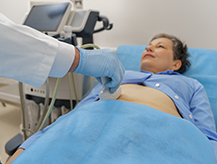What is HRD testing
You may have heard of HRD testing, but what does it mean and how does it impact your treatment options?
If you are diagnosed with stage 3 or 4 high grade serous ovarian cancer (or fallopian tube or primary peritoneal cancer) you will be offered testing of your tumour.
Testing your tumour for gene changes is also known as somatic testing. This picks up any gene changes or mutations that have happened in your tumour cells, and can help inform your cancer team about which treatments might be most effective.
Somatic testing (tumour testing): tests for gene faults in your cancer cells. These changes developed as the cells have mutated and become cancerous. It is done by looking at a sample of your tumour.
Germline testing: this is testing to find out whether there is gene fault that is present in every cell in your body. This means it can be passed down to your children and can increase the chances of other types of cancer. It is done through a blood (or saliva) test.
It is possible to find a gene fault in your tumour (through somatic testing) that is not present in the healthy cells in the rest of your body (germline testing). This still informs treatment, but would mean you are not at greater risk of other cancers and the gene change can’t be passed down to your children. This is why both types of testing are used.
What is HRD ?
In your body, cells are constantly dividing. In this process, plus through day to day environmental factors, damage and mistakes happen all the time. Our bodies have several ways to make sure cells that have gone wrong aren’t allowed to carry on growing and dividing with those errors.
‘Homologous recombination’ is one of the pathways that allows cells to fix DNA damage so they can continue to grow normally.
When this pathway is broken, cells struggle to do this process. This is called ‘homologous recombination deficiency’ (HRD). Cancer cells where this pathway is broken are less able to fix themselves. This is referred to as HRD+ (HRD positive).
You may have heard of faulty BRCA1 or BRCA2 genes. They are just two of the genes involved in this DNA repair function pathway, but there are many more.
Faults in these genes can result in a higher risk of high-grade serous ovarian cancer, but also a better response to maintenance treatments, also known as PARP inhibitors.
Research suggests around half of women with advanced high grade serous ovarian cancers are HRD+1. Of these, around half have a BRCA1/2 fault, and around half have a fault in one of a number of different genes that have a similar impact on how the cells fix errors. These faults can either be germline (in all cells) or somatic (only in the cancer cells).

Proportion of high-grade serous ovarian cancer that is HRD+2
How is HRD testing done?
A sample of your tumour is taken, either through a biopsy or during your surgery to remove your cancer. The sample is then sent to a specialized lab to be examined.
HRD testing looks for changes in chromosomes that identify that a cell is HRD+ regardless of which specific gene is impacted.
BRCA1/2 are both types of HRD, so if you have already been told you have a faulty BRCA gene, or a positive BRCA tumour test, you are classed as HRD+. However, the HRD test is different to the BRCA test, so if your tumour doesn’t test positive for BRCA, you should still be offered an HRD test to look for other gene faults in your tumour.
Why is HRD testing important?
HRD testing directly impacts treatment choices.
Research shows that patients whose tumour is HRD+ particularly benefit from PARP inhibitors1 because PARP inhibitors can take advantage of this weakness to target cancer cells, so they cannot survive. This is why the eligibility criteria for certain PARP inhibitors specifically state they are only for people whose tumour has been found to be HRD+.
For this reason, it’s important for ovarian cancer patients to have the testing they are eligible for so they can access all available treatment options.
There are options available for people who aren’t HRD, so don’t panic if your test results show this. Your cancer team will be able to talk through what maintenance treatments are currently available.


